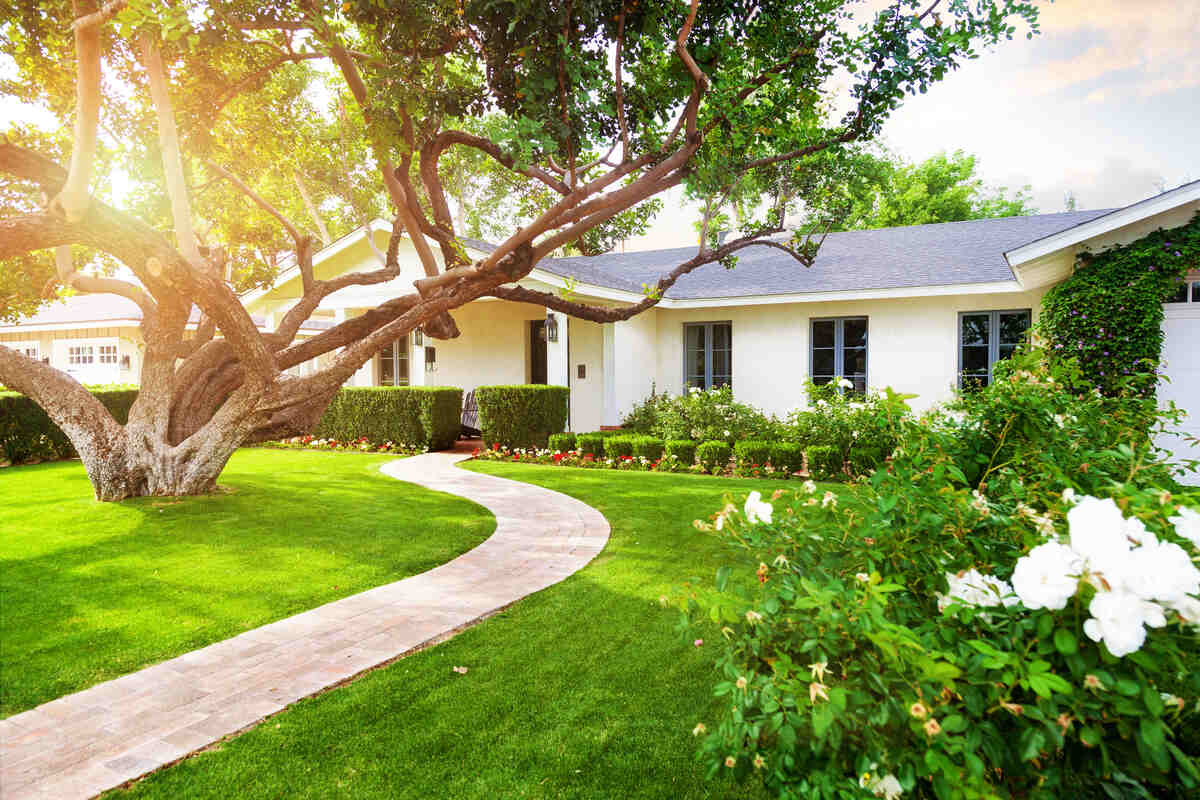
The best grass for Arizona differs across the state. If you live in the low Phoenix area, you get excellent results with summer grasses like Bermuda, Buffalograss, and St. Augustine, which can take a lot of heat. Up in the mountains, Flagstaff, Payson, and Prescot have shorter summers, colder winters, and snow. Only cool-season grasses can truly thrive there.
Overall, you can choose from nine excellent grass types for your Arizona lawn. Here’s all the information you need to pick the right one for your location, elevation, and green thumb level.
- 1. Midiron: Best Bermuda for Family Lawns
- 2. Tifway: Best Turf for a Manicured Phoenix Lawn
- 3. Palmetto St. Augustinegrass: Best Choice for Arizona’s Shady Lawns
- 4. Buffalograss: Best for No-Mow Lawns
- 5. Blue Grama: A Good Option for Naturalistic Lawns
- 6. Zoysiagrass: Best Low-Maintenance Grass for Shady Lawns
- 7. Kentucky Bluegrass: Best For Mid and High Altitude
- 8. Perennial Ryegrass: Best for Overseeding a Bermuda Lawn
- 9. Tall Fescue: Most Heat-Tolerant Winter Grass
- How to Choose the Best Grass for Arizona
- Best Grass Types for Northern Arizona
- Best Grass Types for Southern Arizona and the Low Desert Regions
- Overseeding Your Arizona Lawn
- FAQ
1. Midiron: Best Bermuda for Family Lawns
Bermudagrass is Arizona’s top warm-season turf, and Midiron is its most low-maintenance cultivar. Midiron Bermuda is excellent for home lawns with shallow soil that get a lot of sun and heat. It grows moderately dense and displays a beautiful bright blue-green color from spring to late fall.
It also recovers like magic from pets and children running around on the lawn. Remember that it goes dormant during the winter, and you must overseed it with ryegrass to keep the yard green during the cold season.
Regions in Arizona where Midiron Bermuda thrives: Southern cities like Phoenix, Tucson, Mesa, and most locations under 3500 feet elevation, including Kingman and Mesquite.
Classification: Warm-season grass.
Established by: Sod or seeds available in retail nurseries or online.
Drought tolerance: High. The best drought tolerance among all Bermudagrasses.
Cold tolerance: The most cold-resistant of Bermuda varieties.
Shade tolerance: Low.
Foot traffic tolerance: High. Midiron is incredibly tolerant to wear.
Potential for diseases and pests: Low.
Soil type: It thrives in sandy soils, loam, and clay. Tolerates shallow soils.
Maintenance:
- Midirion grows well with one fertilizer application a year. Use a blend of nitrogen, phosphorus, and potassium.
- Water thoroughly every five days to promote a deep root system.
Mowing height:
- Mow Midiron Bermuda 1.5 to 2.0 inches with a rotary mower, or keep it lower at 0.5 to 1.5 inches with a reel mower.
- It requires mowing once a week.
Where to buy Midiron Bermudagrass:
– Southwest Sod – Midiron sod
– West Coast Turf – E-Z Turf for Arizona
– Evergreen Turf – Midiron sod
2. Tifway: Best Turf for a Manicured Phoenix Lawn
Consider Tifway varieties of Bermudagrass if you want an aesthetic upgrade from Midiron. They have great drought, heat, and traffic tolerance with superior looks.
Tifway leaves have a finer texture, the green is slightly darker, and the lawn is denser. Tifway 419 and Tifway II are two Bermuda cultivars often used on golf courses and sports fields for their quality and durability.
Regions in Arizona where Tifway thrives: Southern cities like Phoenix, Tucson, Mesa, and most locations under 3500 feet elevation, including Kingman and Mesquite.
Classification: Warm-season grass.
Established by: Sod.
Drought tolerance: High. It can withstand long periods without water and keep its color.
Cold tolerance: Good.
Shade tolerance: Moderate. Tifway cultivars tolerate some shade, but the best texture and color are achieved in full sun.
Foot traffic tolerance: High. It recovers quickly from moderate foot traffic damage.
Potential for diseases and pests: Low. It resists common turf diseases such as brown patch disease and pythium root rot.
Soil type: Grows well in various kinds of soils, from heavy clay to sandy. It has excellent tolerance to alkaline soils but also acidic, saline, and poorly drained terrains.
Maintenance:
- Avoid a fixed irrigation schedule and water deeply when the grass turns a darker green, indicating stress.
- Tifway needs 2 to 4 pounds of nitrogen per 1000 sq. ft. per year.
- Apply only potash in February and September. Use a mix of nitrogen, phosphorus, and potassium with added iron from March to August.
Mowing height:
- You get the best-looking lawn mowing Tifway at ½ to 1 inch (use a reel mower).
- Mow weekly or twice a week during the growing season.
Where to buy Tifway Bermudagrass:
– Tifway 419 by Super Sod
– Sod Solutions – 419 Bermuda Sod
– King Ranch Turfgrass – Tifway 419 Bermuda
3. Palmetto St. Augustinegrass: Best Choice for Arizona’s Shady Lawns
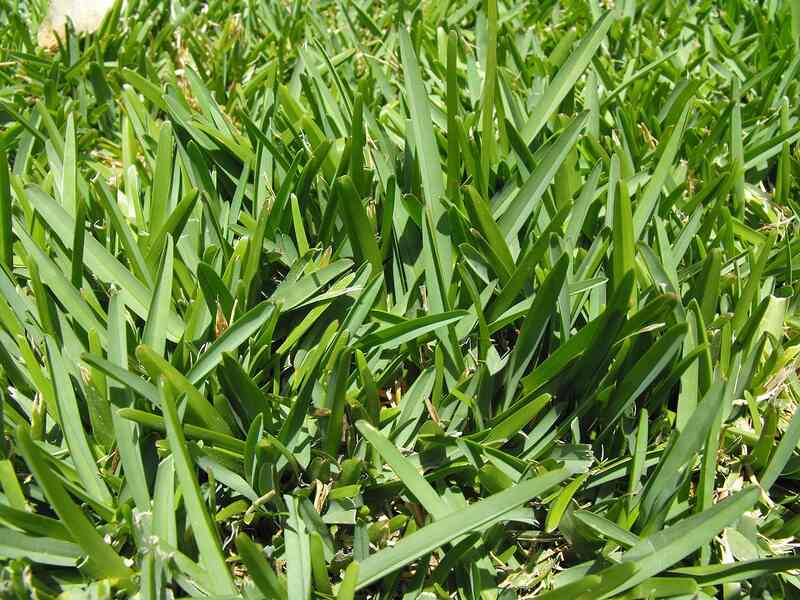
Palmetto is the best warm-season turfgrass for you if your Arizona lawn has large shaded areas. Homeowners prefer it over other St. Augustinegrass varieties because of its superior tolerance to shade, cold, heat, and drought, but also for its looks.
It is a semi-dwarf variety with a lovely, plush appearance. The blades have a vivid emerald green color with a coarse texture and rounded tips that make them soft to the touch. However, it doesn’t do as well with overseeding as the Bermuda varieties.
Regions in Arizona where Palmetto St. Augustine thrives: Southern and central low deserts. Consider Palmetto for your lawn if you live under 3500 feet elevation. Avoid it if you get snow on your lawn in the winter.
Classification: Warm-season grass.
Established by: Sod, plugs, and sprigs.
Drought tolerance: High. Palmetto’s particularly extensive root system gives it exceptional drought and heat tolerance.
Cold tolerance: Good. More cold-tolerant than other St. Augustinegrasses.
Shade tolerance: Good. This St. Augustine cultivar is an excellent filler grass for areas under trees and bushes.
Foot traffic tolerance: Good tolerance to moderate traffic with fast recovery.
Potential for diseases and pests:
- Palmetto is prone to gray leaf spot disease if overwatered.
- As for pests, it is especially vulnerable to chinch bug infestations. White grubworms should be watched for as well.
Soil type: Grows in various soils, tolerating sandy soils, sandy loam, clay, and damp soils.
Maintenance:
- Low-maintenance grass that thrives with minimal watering and fertilization.
- Less prone to thatch.
Mowing height:
- For best results, mow St. Augustine at 1.5 to 2.5 inches tall.
- Use a rotary mower and make sure the blades are sharp.
Where to buy Palmetto St. Augustinegrass:
– Florida Foliage St. Augustine Palmetto (72 grass plugs)
– Circle C Farms St. Augustine Palmetto (72 grass plugs)
– SmartMe St. Augustine Palmetto 3-inch sod plugs (18 plugs)
4. Buffalograss: Best for No-Mow Lawns
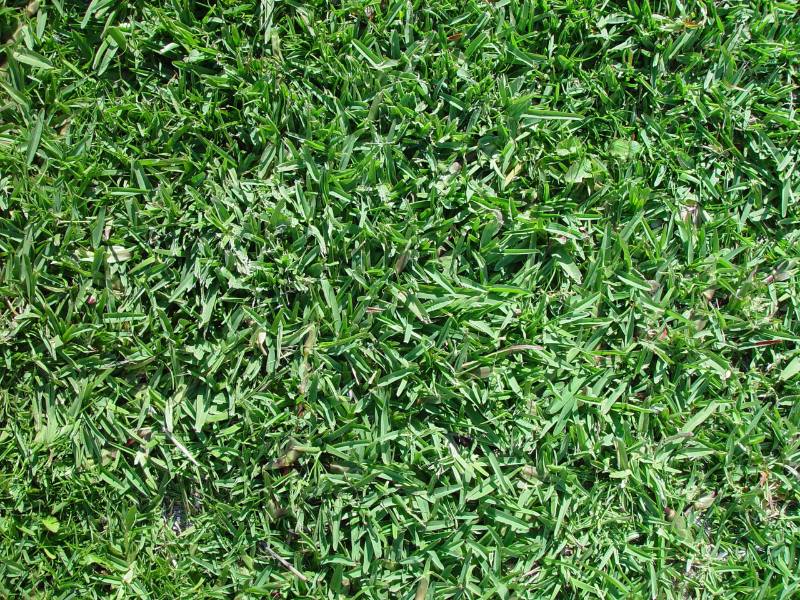
Photo Credit: Pixnio
Buffalograss grows naturally in some parts of the Grand Canyon State and is perfectly adapted to the Arizona climate and soil. It requires much less maintenance than many other turfgrass species used for lawns.
It’s a low-growing perennial grass that spreads like turf with thin blue-green leaves. With its meadow-like appearance, buffalograss is more suitable for natural-looking lawns than formal landscaping. It has a soft texture, is pleasant on bare feet, and grows a lovely lush, dense carpet around pools and patios if mowed.
Regions in Arizona where Buffalograss thrives: Lower areas in south and central Arizona (Phoenix, Mesa, Tucson, Mesquite, etc).
Classification: Warm-season grass.
Established by: Seed, plugs, and sod.
Drought tolerance: High. It can handle prolonged drought and extreme temperatures.
Cold tolerance: Low to moderate.
Shade tolerance: Low. It thrives in full sun.
Foot traffic tolerance: Low.
Soil type: Thrives in native, well-drained clay soils. Doesn’t do well in sandy soils.
Maintenance:
- Buffalograss has low nitrogen needs, so fertilization is optional. If you want to add some nutrients, keep it under two pounds of nitrogen per 1000 square feet per year.
- The right fertilizer has a ratio of 3-1-2 or 4-1-2 (nitrogen to phosphorus to potassium) and at least 35% slow-release nitrogen.
- Ensure 1 inch of water per week. Irrigate only when that amount is not covered by rainfall.
Mowing height:
- Keep buffalograss 2 to 3 inches in height. Mow once every 3 to 4 weeks to keep it in shape.
- Or, cut once in the spring to remove old growth and leave it to grow to its natural height, 8 to 10 inches tall, for a more natural meadow-like look.
Where to buy Buffalograss:
– Everwilde Farms Buffalograss Seeds (1 lb. of seeds)
– Buffalograss seed (primed) (5-lb. bag)
5. Blue Grama: A Good Option for Naturalistic Lawns
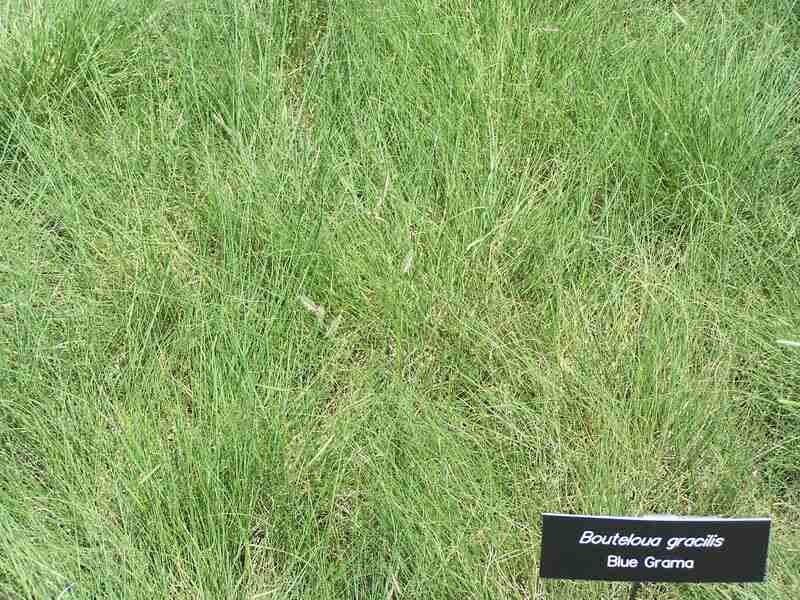
Photo credit: SEWilco / Flickr / CC BY-SA 3.0
Blue grama grows naturally in Arizona from 3500 feet to about 7500 feet in elevation. It has a fine texture and narrow, bluish-gray leaves which grow in beautiful clumps. The foliage turns golden brown in autumn and sometimes gets unique shades of orange or red.
Its small size makes it an excellent plant for rock gardens, unmowed meadows, or other informal areas in the landscape. Pair it with cacti, succulents, and other beautiful plants that are hardy enough for the Arizona heat. You can also grow blue grama as turfgrass with regular mowing.
Regions in Arizona where blue grama thrives: Below 3500 feet elevation in the lower areas of south and central Arizona (Phoenix, Mesa, Tucson, Mesquite, etc.).
Classification: Warm-season grass.
Established by: Seeds.
Drought tolerance: High.
Shade tolerance: Low. Enjoys full sun. It can tolerate partial shade but not dense shade.
Cold tolerance: High.
Foot traffic tolerance: Low.
Soil type: It grows well in various soil types, from sandy to loam and heavy clay. Prefers well-drained soils. It has a good tolerance for slightly acidic and alkaline soils (pH of 6.6 to 8.4).
Potential for diseases and pests: Blue grama resists most grass diseases in central Arizona.
Maintenance:
- Water blue grama every 7 to 10 days during your summer grass care routine to maintain its green color.
- To conserve water, you can irrigate only during extended dry spells.
- Fertilization needs are low. Apply 1/2 lb. of nitrogen per 1000 square feet once a year in June.
Mowing height:
- You can keep it unmowed for a natural look. Trim it once in February to remove the old growth.
- For a turf-like appearance, mow blue grama 2 to 3 inches tall. It has a slow growth rate. You can trim about 2 or 3 times during the growing season.
Where to buy blue grama grass:
– Everwilde Farms Blue Grama Grass Seeds (1 lb.)
– Nature’s Seed Blue Grama Grass Seeds (1 lb.)
6. Zoysiagrass: Best Low-Maintenance Grass for Shady Lawns
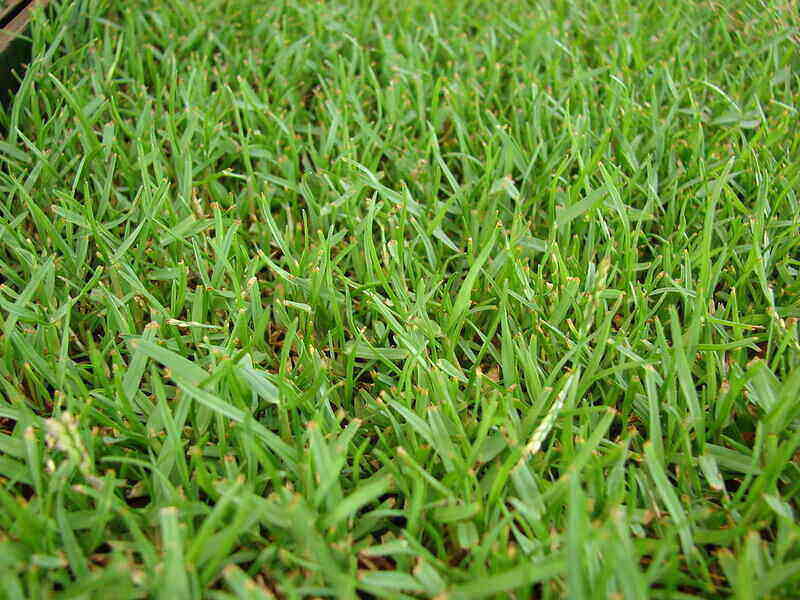
Another good option for hot city lawns in Arizona, Zoysiagrass has a lovely emerald green color and excellent traffic tolerance. It is a low-maintenance grass (after the first year when it’s pretty challenging to establish) and a slow grower. But, it gets thick and dense enough to keep most weeds away.
It’s worth noting that Zoysia thrives in slightly acidic soils. To keep it happy in the alkaline conditions of Arizona, you’ll need to amend the soil regularly. Like St. Augustine, Zoysia has good shade tolerance for a warm-season grass, but it is a much lower maintenance option compared to St. Augustine.
Regions in Arizona where Zoysia thrives: Zoysia has the same growing zones as Bermuda in Arizona, mainly in the low deserts (it needs at least four warm months to grow healthy).
Classification: Warm-season grass.
Established by: Sod, sprigs, and plugs, it spreads by stolons and rhizomes in your garden, repairing bare spots and traffic damage.
Drought tolerance: Moderate to High.
Cold tolerance: Low.
Shade tolerance: Moderate. It tolerates light to moderate shade.
Foot traffic tolerance: High but recovers slowly from damage, especially during the summer.
Soil type: Prefers well-draining soils with a pH of 6.0 to 6.5. Some cultivars are more tolerant of a wide range of soils than others.
Potential for disease: Good disease tolerance overall
Maintenance needs:
- It has low nitrogen fertilization requirements.
- After about 2 or 3 years, it will form thatch thick enough to need removing.
- Zoysia is prone to iron chlorosis and yellowing in the alkaline Arizona soil. You must lower the soil pH and treat the iron deficiency periodically.
Mowing height:
- If you prefer a short lawn, mow the grass at 1.5 inches when it reaches 2.0 inches. Use a reel-type mower.
- Homeowners that enjoy a higher-cut lawn should mow Zoysiagrass at 2.5 inches when it reaches 3.0 inches with a rotary-type mower.
Grass Plug and Seed Options:
– Zoysia Plugs (50 Large Grass Plugs)
– Zoysia Plugs (50 Full & Lush Grass Plugs)
– Zoysia Plugs (100 Plugs)
– Zenith Zoysia Grass Seeds (1/8 lb. of seeds)
7. Kentucky Bluegrass: Best For Mid and High Altitude

Photo Credit: Shutterstock
Widely spread across the U.S., Kentucky bluegrass is the “high elevation Bermuda,” thriving in mid and high altitudes. It’s a familiar cool-season turf in Flagstaff, the White Mountains, and Payson. You can recognize it by its upright, smooth, narrow, bluish-green leaves and its less dense coverage.
Kentucky bluegrass has good foot traffic tolerance and recovers quickly from damage. Its deep root system also tolerates drought conditions better than other cool-season grasses.
Regions in Arizona where Kentucky bluegrass thrives: In areas over 5500 feet in elevation (Flagstaff, Prescott, Page, Sedona, etc.). Communities around Grand Canyon National Park do well with this grass mixed with tall fescue for a better look during the summer.
Classification: Cool-season grass.
Established by: Seed. It spreads by rhizomes.
Drought tolerance: Moderate.
Cold tolerance: Very good.
Shade tolerance: Low.
Foot traffic tolerance: Moderate.
Soil type: Performs best in well-drained, heavy soils with high fertility and a pH of 6 to 7.5.
Potential for diseases and pests:
- Kentucky bluegrass is prone to leaf spot/crown rot syndrome in the spring (worse during cloudy weather).
- Other significant diseases to watch for are summer patch and necrotic ring spot, active primarily during summer.
Maintenance:
- Requires regular mowing during the growing season.
- Fertilize 3 to 4 times a year.
Mowing height: Set mowing height between 2.5 and 3.5 inches.
Grass Seed Options:
– Jonathan Green (11970) Blue Panther Kentucky Bluegrass Grass Seed (3 lbs.)
– SeedRanch Midnight Kentucky Bluegrass Seed (5 lbs.)
8. Perennial Ryegrass: Best for Overseeding a Bermuda Lawn
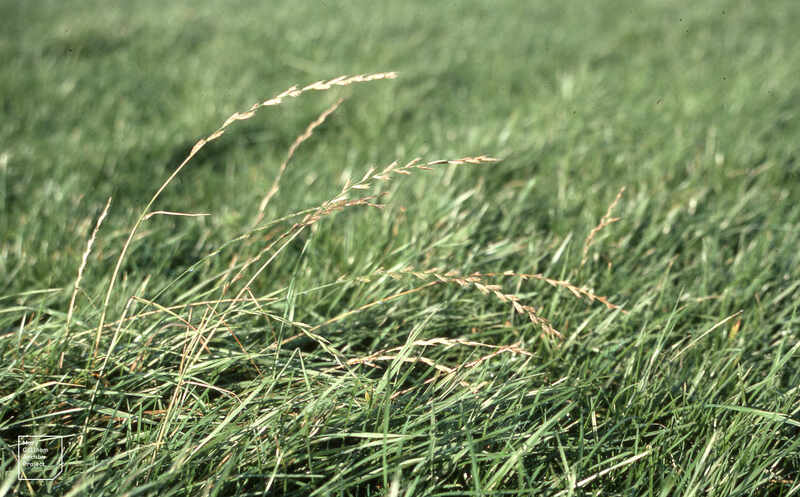
Warm-season grasses, including Bermuda, go dormant during winter months, even in the low regions of the Sonoran desert. To keep the lawn green year-round, most homeowners overseed with perennial ryegrass.
Perennial rye is a beautiful cool-season grass with thin, dark green blades. It makes for a high-quality winter turf with excellent resistance to frost and diseases. You can also choose annual rye, cheaper and easier to transition in the summer but a lighter green.
Overseed with ryegrass in October to give the root system plenty of time to grow before the cold sets in.
Regions in Arizona where perennial ryegrass thrives: It thrives at an elevation between 3500 to 7500 feet. The higher the altitude, the easier it is to keep it green during the summer. Perennial ryegrass can be used across the state as a temporary overseeding option in winter.
Classification: Cool-season grass.
Established by: Seed. Has a bunch-type growth habit.
Drought tolerance: Low. It requires regular watering to keep its green color.
Cold tolerance: Very good.
Shade tolerance: Low.
Foot traffic tolerance: High.
Soil type: Prefers well-drained, fertile soils but tolerates moderate drainage. Rye can grow in soils with a pH between 5 and 8.
Potential for diseases and pests: High. Common diseases include gray leaf spots, red thread, and leaf spots (melting-out).
Maintenance:
- It’s a slow grower and needs moderate mowing and fertilization.
- Thatch is not significant.
Mowing height:
- Mow first after seeding when the grass reaches 2.75 to 3 inches.
- Set the mowing height to 1.5 to 2.5 inches for an established perennial ryegrass lawn.
- Keep the lawn mower blades at 1.5 to 3.0 inches for annual ryegrass.
Grass Seed Options:
– Outsidepride Perennial Ryegrass Seed (5 lbs.)
– Eretz ProTurf Perennial Ryegrass Fine Lawn Seed (choose your size)
9. Tall Fescue: Most Heat-Tolerant Winter Grass

Aaron J. Patton, Ph.D. / Turfgrass Extension Specialist at Purdue University
With the best heat tolerance among the winter grasses of Arizona, tall fescue is a top low-maintenance choice for lawns between 3500 feet and 7500 feet in elevation. It also tolerates shade, making it a good option for lawns with trees, shrubs, and tall buildings nearby.
Kingman, Nogales, Douglas, and Sedona are examples of cities that can use tall fescue extraordinarily well as turfgrass. Consider a mix with Kentucky bluegrass to keep the lawn perfect during winter above 5500 feet.
Regions in Arizona where tall fescue thrives: Tall fescue grows well up in Flagstaff and the cities that outline the mountain down the hill.
Classification: Cool-season grass.
Drought tolerance: Moderate to High.
Cold tolerance: Very good.
Shade tolerance: Moderate.
Foot traffic tolerance: Moderate. Tall fescue can handle moderate traffic well during spring, fall, and winter. In the summer heat, it can be slow to regrow when damaged.
Soil type: Adapted to a wide range of soil conditions but prefers fertile clay soils with good drainage. It has an affinity for slightly acidic soils but tolerates somewhat alkaline (pH of 5.5 to 7.5).
Potential for diseases and pests: Tolerant of most diseases when adequately maintained.
Maintenance:
- In Phoenix, Tucson, and low desert regions, apply 1.0 lb. nitrogen per 1000 square feet in late September and again in late October. Set the sprinkler system to about 2 inches of water per week.
- Make the same fertilizer applications at higher altitudes on September 15 and again on October 15. Lawns in Prescott, Payson, and the surrounding areas also need less water during summer, about 1.5 inches weekly.
- Tall fescue handles drought by growing deep roots. If planted in shallow soil, it needs more frequent watering.
Mowing height:
- For a tighter, more manicured lawn, mow the grass to 2.5 inches when it reaches 3.0 inches tall.
- For a low-maintenance lawn, mow at 3.0 inches when it reaches 3.5 to 4.0 inches.
Where to buy tall fescue:
– Triple-Play Tall Fescue Grass Seed Blend (5000 sq ft)
– Eretz Kentucky 31 K31 Tall Fescue Grass Seed (choose your size)
– Pennington The Rebels Tall Fescue Grass Seed Mix (7 lb.)
How to Choose the Best Grass for Arizona
When choosing a type of grass for your Arizona lawn, consider the following factors:
Sun Exposure
Under proper sun exposure, grass grows thick, lush, and healthy. Both summer and winter grasses have different shade tolerance you need to consider before planting.
- Bermuda, Buffalograss, blue grama, ryegrass, and Kentucky bluegrass thrive in full sun.
- Palmetto St. Augustine and Zoysia love direct sunlight but tolerate some shade (you can grow these grass types near trees and shrubs).
- Tall fescue is ideal for a lawn with more shade than sun (it can’t handle the torrid Arizona sun directly for a long time).
Elevation
Most summer grasses thrive in the low deserts and up to 3000 – 4000 up the hills and mountains. Winter grasses grow best above 3000 feet. Here’s what grasses to consider for your lawn depending on the altitude, according to the University of Arizona:
| Below 3000 feet elevation | Between 3000 and 4200 feet elevation | Between 4300 and 7500 feet elevation |
| Bermudagrass Zoysiagrass St. Augustinegrass Buffalograss Tall fescue | Bermudagrass Tall fescue Kentucky bluegrass Buffalograss | Creeping red fescue Blue grama Kentucky bluegrass Perennial ryegrass Tall fescue fair Hard fescue Chewings fescue Poa trivialis |
Maintenance Level
Go for Tifway if you want an exquisite-looking lawn and have the time (or money) to invest in mowing, fertilizing, and watering the lawn. Choose Midiron if you’re looking for low-maintenance grass. Buffalograss or blue grama are best if the idea is a no-mow lawn.
Learn more about what goes into local lawn maintenance in our guide on how to grow grass in Arizona.
Best Grass Types for Northern Arizona
Cool-season grasses such as ryegrass, Kentucky bluegrass, and fescue varieties are the top choice for cooler climate zones in Arizona. They grow well in the Northern part of Arizona (Kingman, Globe, Safford) and higher elevations over 4500 feet (Cochise County, Verde Valley area, Window Rock).
Since tall fescue tolerates heat better, it is often mixed with Kentucky bluegrass to ensure a good-looking lawn at mid-altitudes during the summer. Over 5500 feet, the same mix provides superior hardiness and a healthy lawn during winter.
Best Grass Types for Southern Arizona and the Low Desert Regions
If you live in Phoenix, Tucson, Mesa, or Yuma, the best turfgrass for your lawn is a heat and drought-resistant summer grass variety. The most popular options are:
- Bermuda (Midiron, Tifway 419, and Tifway II)
- St. Augustine (Palmetto)
- Buffalograss
- Zoysiagrass
- Blue grama
Bermuda is the favorite if you want to overseed with rye over the winter. Zoysia also tolerates overseeding, but not as well. Don’t overseed St. Augustine.
Overseeding Your Arizona Lawn
The key to having a green lawn year-round in the low deserts of Arizona is overseeding with winter grass. Spreading perennial ryegrass seeds over a Bermuda cultivar is the most common combination.
Bermuda stays green from May to September, while ryegrass is actively growing from October through May. You typically need to adjust lawn care (watering and fertilizing) to ensure a smooth transition from late spring to early summer, but the process is as easy as overseeding. We have a detailed guide about winter grasses in Arizona for green thumb homeowners with a DIY project in mind.
FAQ About the Best Grass for Arizona
The most popular summer grass grown in Arizona is the Midiron cultivar of Bermudagrass. It is a low-maintenance, drought-tolerant grass with a beautiful blue-green color and good tolerance to heavy foot traffic.
Most of Arizona has hot, dry summers and winters that are cold enough to send summer grasses into dormancy. There’s no single turfgrass to keep green year-round in the Phoenix area. But, you can have a beautiful, green lawn year-round by having Bermuda as permanent grass overseeded with ryegrass in the winter.
Perennial ryegrass is the best winter grass for the cold season in Arizona. It has excellent cold and drought tolerance and a beautiful dark-green color.
Arizona has various native grasses perfectly adapted to its climate and soils. Blue grama (mesquite grass), top Arizona cottontop, and tangle head are the most popular.
The best times to plant grass in Arizona for a year-round green lawn are late spring to early summer (May, June) for summer grass and early to mid-October for winter grass.
Like with choosing the right grass, you have to have to be selective about the plants in your landscape when you live in Arizona. We recommend checking out our list of the best plants for Arizona heat before planting anything.
Install the Best Turfgrass on Your Arizona Lawn!
Arizona’s dry, hot climate makes growing green, healthy grass challenging, so choosing the right turf type is essential. The best grass for your yard depends on the soil, shade, and elevation. Rainfall, water access, and your time for mowing and proper fertilization also count.
Luckily, you’ve got excellent professionals nearby to help you decide. LawnStarter gives you access to top local lawn care companies to install the best turfgrass in Phoenix, Mesa, Scottsdale, Glendale, and across the Grand Canyon state.
Main Image Credit: Shutterstock